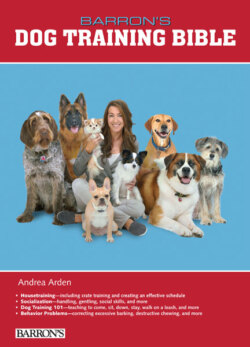Читать книгу B.E.S. Dog Training Bible - Andrea Arden - Страница 14
На сайте Литреса книга снята с продажи.
Commitment and Compliance
ОглавлениеMost people start out with the best of intentions when they get a dog. They imagine how their dog will behave (for example, he won’t jump onto the furniture). Yet, in a short time, their dog behavior wish list has been replaced by a list of behavior problems and excuses for why they developed.
Inconsistency is a major reason for this. Good intentions are meaningless without realistic expectations and a consistent agenda of helping your dog learn the behaviors that you want from him. You cannot expect your dog to be mannerly and quiet if you are in the habit of praising him for jumping around and howling with excitement when you arrive home. This lack of consistency can be quite confusing for dogs and will most likely lead to disappointment for the family in regard to their dog’s overall behavior.
CHECKLIST
Training Expectations
Most people share the same general training goals. They hope for a dog that is friendly and safe, mannerly, responsive to requests, housetrained, and trustworthy when unsupervised. However, specific expectations vary. Clarify your goals by making a list of behaviors you consider important in your dog. For example:
Dog Behavior Wish List
– How would you like your dog to greet people?
– Where should your dog eliminate?
– What should he chew, and more importantly, refrain from chewing?
– How should he behave when left alone?
– When is barking permissible and when should it stop?
– What cues or commands should he respond to reliably?
– How should he react when you take something away from him?
– Is he allowed to jump on the furniture?
While your family is setting goals and expectations for your dog’s behavior, you should also discuss the reasons why they are important. This way, everyone will be motivated to follow through with training. For instance, a dog that doesn’t come when called can be seriously hurt if he happens to slip from his leash on a busy street. A dog that consistently eliminates on rugs is in danger of being relinquished to a shelter. Consistently encouraging your dog’s behavior in the right direction requires a team effort.
TRAINING TRUTH
Curb Your Frustration
Dogs thrive in situations where rules and boundaries are clearly defined and communicated to them in a calm, consistent manner.
Most families consider their expectations of dog behavior to be simple. Therefore, it should be easy for their dog to understand and follow these rules. Although dogs are adept at integrating themselves into our homes and hearts, the human world is a complicated place. Behaviors that are perfectly normal and acceptable in the canine world, such as marking, barking, digging, scavenging, humping, and threatening in the face of fear, are often at odds with human expectations.
It is unfair and unrealistic to assume that your dog will automatically understand what is expected of him. You must make a consistent effort to communicate this information if you want your dog to make the right behavior choices. In many cases, well intentioned, loving pet parents may treat their dogs unfairly because they are frustrated by their dog’s misbehavior. As a result, the dog becomes overwhelmed and confused.
A great deal of frustration can be avoided if you learn to recognize your dog’s propensity to behave in certain ways. This may be due to genetics and/or experiences. You should certainly seek to improve your dog’s behavior, but some dogs may always need special assistance when facing particular challenges. This can include dogs that have social issues in the presence of people or other dogs, and dogs with resource-guarding issues (guarding things they consider valuable, such as chew toys and food bowls).
In these cases, training should focus on managing the dog’s time to minimize situations that may exacerbate the problem in addition to creating more positive responses.
